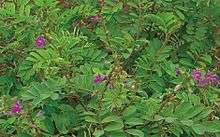Tephrosia purpurea
| Wild indigo | |
|---|---|
 | |
| var. purpurea | |
_in_Narshapur%2C_AP_W_IMG_0765.jpg) | |
| Scientific classification | |
| Kingdom: | Plantae |
| (unranked): | Angiosperms |
| (unranked): | Eudicots |
| (unranked): | Rosids |
| Order: | Fabales |
| Family: | Fabaceae |
| Tribe: | Millettieae |
| Genus: | Tephrosia |
| Species: | T. purpurea |
| Binomial name | |
| Tephrosia purpurea (L.) Pers. | |
Tephrosia purpurea is a species of flowering plant in the pea family, Fabaceae, that has a pantropical distribution. It is a common wasteland weed. In many parts it is under cultivation as green manure crop. It is found throughout India and Sri Lanka[1] in poor soils.
Common names include: Bengali: জংলী নীল (Jangli neel), বন নীল।
English: Fish poison, Wild indigo
Hawaiian: ʻAuhuhu, Ahuhu, ʻAuhola, Hola
Hindi name: Sarphonk, Sharpunkha
Rajasthani: Masa
Tamil: Kollukkai Velai (கொள்ளுக்காய்_வேளை)
Telugu: Vempali (వెంపలి)
Uses
Used as a fish poison; the leaves and seeds contain tephrosin, which paralyzes fish. Larger doses are lethal to fish, but mammals and amphibians are unaffected. It is also used traditionally as folk medicine. According to Ayurveda, the plant is anthelmintic, alexiteric, restorative, and antipyretic; it is used in the treatment of leprosy, ulcers, asthma, and tumors, as well as diseases of the liver, spleen, heart, and blood. A decoction of the roots is given in dyspepsia, diarrhea, rheumatism, asthma and urinary disorders. The root powder is salutary for brushing the teeth, where it is said to quickly relieve dental pains and stop bleeding. An extract, termed 'betaphroline' (not a systematic name) is claimed to promote release of endorphins, and finds use in certain cosmetic preparations.
References
- Arnold, M.D., Harry L. (1968). Poisonous Plants of Hawaii. Tokyo, Japan: Charles E. Tuttle Co. pp. 57–58. ISBN 0-8048-0474-5.
- Bishop Museum Hawaiian Ethnobotany Online Database. Downloaded on 24 September 2007.